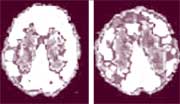For many years, police and psychologists have tried to understand the minds of cold-blooded murderers but have found little. Now, they are getting closer than ever to uncovering the unusual features in the brains of these individuals.
 |
| Professor of Psychology at the University of Southern California – Adrian Raine (Photo: BBC) |
Notorious serial killers like Ted Bundy, Jeffrey Dahmer, and David Berkowitz evoke horror in everyone who hears their names. What were they thinking? What went on in their heads? Is there something different about their brains?
Normal Brains vs. Killer Brains
Adrian Raine, a psychology professor at the University of Southern California, has sought to answer these questions by examining the brains of these murderers. He utilized two scanning techniques: Positron Emission Tomography (PET), which reveals how the brain functions, and Magnetic Resonance Imaging (MRI), which allows him to study the structural aspects of the brain.
Raine compared the function and structure of the brains of 41 murderers with those of 41 individuals under supervision and found a lower level of flexibility in the prefrontal cortex (the area above the eyes and behind the forehead) of the murderers compared to the flexibility of the supervised individuals. Raine explains that the prefrontal cortex acts as a sort of “brake” in the human brain, and since these individuals have poor prefrontal function, they cannot control or regulate their emotions. However, Raine believes that while there are many connections between prefrontal function and aggression, the abnormal brain activity cannot be the sole reason for violent behavior; environmental and social factors also play a significant role in turning an individual into a murderer.
 |
| Normal brain (left) and problematic brain (Photo: cand) |
He divided these murderers into two groups: the “emotionally reactive” murderers and the “predatory” murderers (where emotionally reactive refers to those who kill impulsively, while predatory refers to those who kill with premeditation). Although some of them could not be definitively classified into one of the two groups, Raine identified 15 out of the 41 as predatory and 9 as impulsive. He discovered that while emotionally impulsive murderers had less flexible prefrontal brain function, the prefrontal activity of predatory murderers remained normal. Both groups exhibited higher-than-normal activity in subcortical regions of the brain, which is an ancient and deeper part of the brain.
“This part of the brain increases aggressive feelings and may stimulate violent behavior,” Raine said. “One key difference between these two groups of murderers is that emotionally reactive individuals, who have a lot of aggressive emotions, cannot control their behavior because their prefrontal function is not working effectively.”
In contrast, those who kill with intent (predatory murderers) may feel anger and hostility, but their prefrontal cortex functions well enough to regulate, control, and redirect their aggressive behaviors into actions that may be enjoyable to them. According to Raine, because they carefully plan their actions, it is difficult to catch these cold-blooded and brutal murderers as they have thought through and prepared for their crimes.
Due to “infected” brains from an early age
“It seems that the seeds of violence are sown very early in their lives,” Raine stated. “Of course, social factors also play a significant role. We know that individuals who suffer complications at birth or are neglected by their parents during early childhood are often more likely to become violent criminals.”
Raine concludes that what we really need is more research in this field, but research that leads to practical applications so that we can do something to rehabilitate criminals and murderers and help those who are impulsive avoid the path of crime and reintegrate into society.
Nội Hà


















































